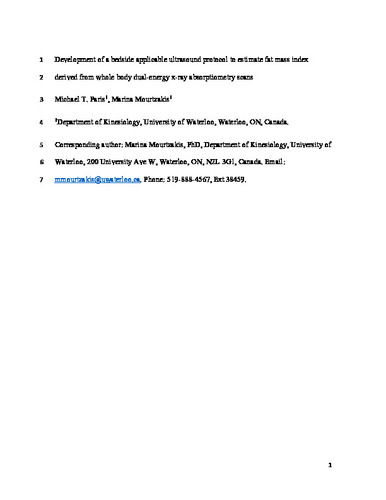| dc.contributor.author | Paris, Michael | |
| dc.contributor.author | Mourtzakis, Marina | |
| dc.date.accessioned | 2023-05-10 15:57:40 (GMT) | |
| dc.date.available | 2023-05-10 15:57:40 (GMT) | |
| dc.date.issued | 2019-01 | |
| dc.identifier.uri | https://doi.org/10.1016/j.nut.2018.04.012 | |
| dc.identifier.uri | http://hdl.handle.net/10012/19440 | |
| dc.description | The final publication is available at Elsevier via https://doi.org/10.1016/j.nut.2018.04.012. © 2019. This manuscript version is made available under the CC-BY-NC-ND 4.0 license http://creativecommons.org/licenses/by-nc-nd/4.0/ | en |
| dc.description.abstract | Objectives: Precise measures of adiposity are difficult to obtain in clinical settings due to a lack of access to accurate and reliable techniques. The aim of this study was to develop and internally validate a bedside-applicable ultrasound protocol to estimate fat mass index.
Methods: We conducted an observational cross-sectional study of 94 university and community dwelling adults who attended a single data-collection session. Adipose tissue thickness was quantified in a supine or prone position using the four-site protocol (images two anterior sites on each thigh) and the nine-site protocol (images nine anterior and posterior sites). Adipose tissue thicknesses from the four-site protocol were compared against the fat mass index that was derived from dual-energy x-ray absorptiometry scans. Subsequently, we optimized the accuracy of the four-site protocol with the addition of bedside-accessible adipose tissue thicknesses from the nine-site protocol and easily obtained covariates.
Results: The four-site protocol was strongly associated (R2 = 0.65) with fat mass index but wide limits of agreement (-3.53 kg/m2 and 3.50 kg/m2) were observed using the Bland-Altman analysis. With the addition of the anterior upper arm and abdomen adipose tissue thicknesses as well as the covariates age, sex, and body mass index, the model accuracy improved (R2 = 0.93) and the Bland-Altman analysis displayed narrower limits of agreement (-1.57 kg/m2 and 1.60 kg/m2).
Conclusions: This optimized protocol developed can be applied bedside and provide accurate assessments of fat mass index. | en |
| dc.description.sponsorship | This work was supported by Canada Graduate Scholarship (Master) - Canadian Institute of Health Research, Province of Ontario Ministry of Research and Innovation Early Researcher Award, Canada Foundation for Innovation, Natural Sciences and Engineering Research Council, and Canadian Institute of Health Research. | en |
| dc.language.iso | en | en |
| dc.publisher | Elsevier | en |
| dc.relation.ispartofseries | Nutrition; | |
| dc.subject | adipose tissue | en |
| dc.subject | ultrasound | en |
| dc.subject | dual energy X-ray absoroptiometry | en |
| dc.subject | adipose tissue thickness | en |
| dc.subject | fat mass | en |
| dc.subject | obesity | en |
| dc.subject | body composition | en |
| dc.title | Development of a bedside-applicable ultrasound protocol to estimate fat mass index derived from whole body dual-energy x-ray absorptiometry scans | en |
| dc.type | Article | en |
| dcterms.bibliographicCitation | Paris, M. T., & Mourtzakis, M. (2019). Development of a bedside-applicable ultrasound protocol to estimate fat mass index derived from whole body dual-energy X-ray absorptiometry scans. Nutrition, 57, 225–230. https://doi.org/10.1016/j.nut.2018.04.012 | en |
| uws.contributor.affiliation1 | Faculty of Health | en |
| uws.contributor.affiliation2 | Kinesiology and Health Sciences | en |
| uws.typeOfResource | Text | en |
| uws.peerReviewStatus | Reviewed | en |
| uws.scholarLevel | Faculty | en |

